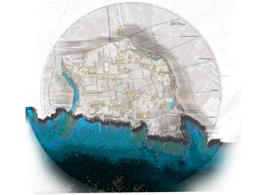STUDENTS PROJECTS
PROJECTS2013
Student: Kyriaki Economou
Supervisors: Panayiota Pyla , Andreas Savvides , Emilios Michael
University of Cyprus
Presentation Date: May 2014
The aim of the thesis was to investigate the development potentiality of the coastline beyond the typically structured approaches (hotels, holiday homes, organized beaches ) . The current case- study is a crucial seaside plot in Paralimni, near the UN buffer zone , next to the restricted area of Varosia at Famagusta.
This diploma thesis investigates the coastal area of Armiropygadon at the town of Paralimni, Cyprus. The area is located next to the UN buffer zone and is basically the coastline area next to the restricted area of Varosia. The particularity of the site lies in the fact that it constitutes one of the three important vacant sites within 1km length of the coastline Cavo Greco-Salamina. However, the site's value as a void is differentiated from the other two, in that it lacks legal institutionalized value(it's neither an archaeological site nor a nature retreat), and instead, it curries the value of the urban void which has the sense of freedom and expectancy. The key question thus is how this specific place could be interpreted considering that it belongs to a wider place where any coastline plot is typically exploited for large hotel units, holiday homes or commercial beaches.

The potentiality of the space is perceived by the current activities occurring there. The latter, due to the buffer zone entering the site, lends a functionally independed status quo to the area, in comparison to the other coastal areas of Famagusta district. In detail, the reported activities are: the agriculture cultivations ignoring the limits and entering the buffer zone area, the fishing at the limit and last but not least the improvised holiday homes constructed during summertime from people coming from the neighbourly village of Derhyneia.
Considering the so far documented data as well as the construction possibility of the site -due to future release of Famagusta restricted area-, is suggested the current situation to be preserved and given a boost. So, the coastline area is exploited in a typically contrary way which nevertheless gives rationale to the already surrounded development.

The above treatment impacts a shift of the coastline's value into the perimeter zone that is adjacent to the void. The owners' construction rights are transferred to the latter area. This is suggested to be done in two ways: plot interchange with government land or otherwise coorporated development with the existed owners of the discussed area. For the essay needs, the perimeter zone it is called buffer zone; an area where agricultural and built environment is suggested to coexist in a way that the existed dipole resident-cultivation collapses.


The adopted islands formed in the area constitute the design tool of the proposed Vaque terrain. The islands are at public disposal and everyone can apply for adoption. Through them the spontaneous appropriation of the area is strengthen and broadened to more users. Between the islands some functional permanent programmes are suggested- the catalysts-, as well as road network, pedestrian and cyclists network, which give boost to the movement between the islands. The islands become the media through which a chance for someone to formulate its own everyday life is given; away from previous homogeneous ways of moving and living in the touristic area of Protaras and the probably future touristic area of Famagusta.

The island rationale is set into practice through the main design proposals. Fistly, the boundaries of the area are set by exploiting the existed estuaries. At the south part of the site the 'river' is deepened and the sea water enters the area. At this point all the water activities occur (fishing and water sports). At the south part the river's vegetation becomes subject to be studied and cared by educational institutions which arrive to the area through riverside path. Within the place the cultivations go into organic farming program since the rich soil of the region is exploited. Furthermore, the plots also host residential units for people who are interested to get involved with the process of production. The products produced are sold in the outdoor market where buyers can cut by themselves from the field or otherwise are pumped into the market building. Residential units are also placed at the beachfront for people who usually spend their holidays in the region but also for new user groups. Several typologies are developed in order to meet different users' requirements and which refer to the way of the existing residents' life.


Finally, the market building-warehouse of biological products becomes subject to design. The latter is done in a manner that specifies also the design of the other two suggested building programs. The materials of the existing river (reeds and stones) are exploited and the design is based on the development of independent selling products units, directly from farmers or fishermen. Main idea is the infrastructure layers on which the design evolvement is based. The production is followed by the products' working out and finally by the sale.



Both the building example as well as the overall urban design aim to let the user to regulate his own activities. General motivation is the area to maintain the character of the non-branded coastal region where one can handle his own time in a framework of multiple options and of freedom in how he conducts.
Related articles:
- Wooden Boatbuilding and Sailing Centre ( 03 February, 2015 )
- Diving Center in Kavala ( 15 February, 2015 )











